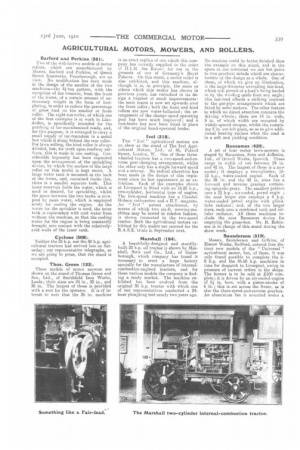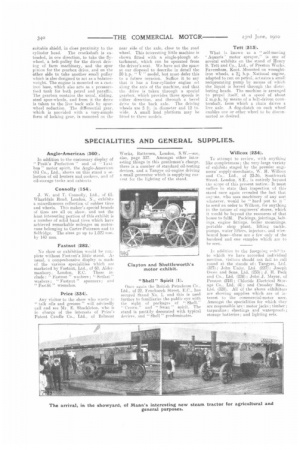AGRICULTURAL MOTORS, MOWERS, AND ROLLERS.
Page 23

Page 24

If you've noticed an error in this article please click here to report it so we can fix it.
Barford and Perkins (281).
Two of the well-known models of motor rollers, which are manufactured by Messrs. Barford and Perkins, of Queen Street Ironworks, Peterborough, are on view. No modification has been made in the design of the smaller of the two machines—the 4)rton pattern, with the exception of the removal, from the front of the frame, of a certain amount of unnecessary weight in the form of footplating, in order to reduce the percentage of gross load on the smaller or front roller. The eight-ton roller, of which one of the first examples is at work in Llandudno, is specifically intended for the patching of tar-macadamized roads, and, for this purpose, it is arranged to carry a small supply of tar-macadam in a metal box which is slung behind the rear roller. For lawn rolling, the hind roller is always divided, but, for work upon roadway surfaces, this is made in one casting. Considerable ingenuity has been expended upon the arrangement of the sprinkling device, by which the surface of the large roller on this model is kept moist. A large water tank is mounted at the back of the frame, and, contained inside this, there is a smaller separate tank. This inner reservoir holds the water, which 18 used as desired, for sprinkling, whilst the space between the two tanks is occupied by inure water, which is employed solely for cooling the engine. As the water for the sprinkler is used, the inner tank is replenished with cold water from without. the machine, so that, the cooling water for the engine is being constantly brought into contact with the relativelycold walls of the inner tank.
Cyclone (308).
Neither the 25 h.p. nor the 50 h.p. agricultural tractors had arrived late on Saturday; our representative telegraphs, as we are going to press, that the stand is occupied.
Thos. Green (125).
Three models of motor mowers are shown on the stand of Thomas Green and Son, Ltd., of Smithfield Iron Works, Leeds; their sizes are 24 in., 30 in., and 36 in. The largest of these is provided with a seat for the operator. It is of interest to note that the 36 in. machine
is an exact replica of one which this company has recently supplied to the order of ILLM. the Iilaissr, fur use in the grounds of one of Germany's Royal Palaces. On this stand, a motor roller is also exhibited, and this machine, although it is, in principle, the same as others which this maker has shown in previous years, has embodied in its design a number of small improvements: the main frame is now set upwards over the front roller ; both the front and hind rollers are now water-ballasted ; the arrangement of the change-speed operating gear has been much improved ; and a foot-brake has now been fitted in place of the original hand-operated brake.
Net (518).
Two " Ivel " agricultural motors are oii show at the 'stand of The Ivel Agricultural Motors, Ltd., of 46, Poland Street, London, W. One of these threewheeled tractors has a two-speed-and-reverse gear-changing arrangement, whilst the other only has a single forward speed and a reverse. No radical alteration has been made in the design of this implement since its last appearance at an exhibition. Each of the examples shown at Liverpool is fitted with an 18.20 h.p., two-cylinder, horizontal type of engine, The two-speed machine has a ClaudelHobson carburetter and a H.T. magneto. An " Ivel " patent attachment, by means of which two six-ft. mowing-machines may bo towed in ilchelon fashion, is shown connected to the two-speed tractor. Both the agricultural motors exhibited by this maker are entered for the R.A.S.E. trials in September next, Marshall (184).
A beautifully-designed and sturdilybuilt 30 h.p. oil tractor is shown by Marshall, Sons and Co., Ltd., of Gainsborough, which company has found it necessary to erect a large factory specially for the manufacture of internalcombustion-engined tractors, and for these various models the company is finding a ready market. The machine exhibited has been evolved from the original 30 h.p. tractor with which one of our representatives conducted a 24hour ploughing test nearly two years ago.
No machine could be better finished than the example on this stand, and in the space at our command we can but point to two practical details which are characteristic of the design as a whole. One of these, of which we give an illustration, is the large-diameter swivelling fair-lead, which will permit of a load's being hauled in by the winding cable from any angle; this fair-lead affords a striking contrast to the gas-pipe, arrangements which are fitted by some makers. The other feature to which we direct attention concerns the driving wheels; these are 14 in. wide, 9 in. of which width are occupied by widely-spaced stropes, whilst the remain. Mg 5 in. are left plain, so as to give additional bearing surface when the road is in a soft and yielding condition.
Ransomes (459). A set of four motor lawn-mowers is staged by Ransomes, Sims and Jefferics, Ltd., of Orwell Works, Ipswich. These range in width of cut between 24 in. and 42 in. The largest of these is a new model; it employs a two-cylinder, 1012 11.p., water-cooled engine. Each cf the 36 in. and the 42 in. sizes has a forward and reverse gearbox containing epicyclie gears. The smallest pattern uses a 2i h.p., air-cooled, petrol engiu ; the next larger size employs a 4 h.p. water-cooled petrol engine with gilledtube radiator; and, of the two larger sizes, each uses a combined tank and cellular radiator. All these machines include the neat Ransomes device for emptying the grass-box. Mr. H. Robinson is in charge of this stand during the show week.
Saunderson (519).
Messrs. Saunderson and Gifkins, of Elstow Works, Bedford, entered four distinct new models of the " Universal " agricultural motor, but, of these, it was only found possible to complete the 6
h.p. and the 45-50 h.p. machines in time for despatch to Liverpool, owing to pressure of current orders in the shops. The former is to be sold at £100 complete; it is driven by an air-cooled engine of 5,1 in. bore, with a piston-stroke of 6 in. ; this is set across the frame, as is also the three-speed-and-reverse gearbox. An aluminium fan is mounted under a
suitable shield, in close proximity to the
cylinder head. The crankshaft is extended, in one direction, to take the flywheel, a belt-pulley for the direct driving of farm machinery, and the spur pinion for the gearbox drive, and on the other side to take another small pulley which is also designed to act as a balanceweight. The engine is mounted on a castiron base, which also acts as a pressurefeed tank for both petrol and paraffin. The gearbox contains the usual, sliding. steel spur-wheels, and from it the drive is taken to the live back axle, by spurwheel reduction. The differential gear, which is provided with a very-simple form of locking gear, is mounted on the
near side of the axle, close to the road wheel. This interesting little machine is shown fitted with a single-plough attachment, which can be operated from the driver's seat. We have not the space at our disposal to describe in detail the 50 h.p. " V " model, but must defer this to a future occasion. Suffice it to say that it has a four-cylinder engine set along the axis of the machine, and that the drive is taken through a special gearbox, which provides three speeds in either direction, and through a bevel drive to the back axle. The driving wheels are 5 ft. in diameter and 12 in. wide. A small load platform may be fitted to these models_
Tett (313).
What is known as a " self-moving Aquaris motor sprayer," is one of several exhibits on the stand of Henry S. Tett and Cn., Ltd., of Preston Works. Faversham, Kent. Mounted on wrought. iron wheels, a 2,'s h.p. National engine, adapted to run on petrol, actuates a small reciprocating pump by means of which the liquid is forced through the distributing heads. The machine is arranged to propel itself, at a speed of about, 2 m.p.h, by means of a belt-driven coontershaft, from which a chain drives a live axle. A dog-clutch on each wheel enables one or other wheel to be disconnected as desired.
































